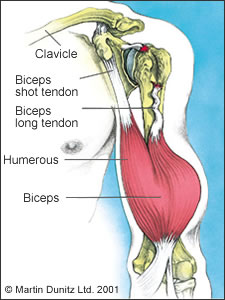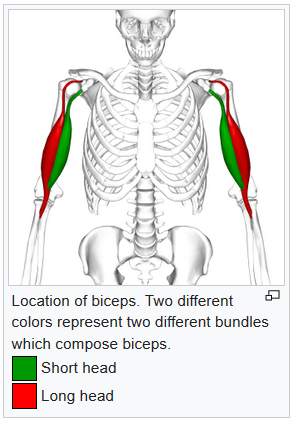nalco group
bone, muscle & joint pain physio
BOOK NOW / WHATSAPP ABOUT YOUR PAIN OR INJURY
- NOVENA 10 Sinaran Drive, Novena Medical Center #10-09, Singapore 307506
- TAMPINES 9 Tampines Grande #01-20 Singapore 528735
- SERANGOON 265 Serangoon Central Drive #04-269 Singapore 550265
Home > Blog > Physiotherapy & Hand Therapy > Conditions > Biceps Tendon Rupture Physiotherapy
Biceps Tendon Rupture Physiotherapy

A biceps tendon rupture happens when the biceps muscle is torn from the bone at the point of attachment (tendon) to the shoulder or elbow.
Most of the time, the biceps tendon is torn at the shoulder.
Usually biceps tendon ruptures happens in men more than women; and usually between 40 to 60 years of age due to chronic wear of the biceps tendon.
For younger patients, biceps tendon tears is usually the result of trauma such as
- sports injuries
- motor vehicle accidents
- falls
- etc
Of course biceps tendon ruptures can also happen to anyone at any age especially
- those who tend to perform repetitive overhead lifting or
- work in occupations that
require heavy lifting and
- in athletes who lift weights or participate in aggressive contact sports
What our senior physiotherapists do to help patients revolve around
- regaining flexibility
- regaining strength
- regaining movement
- regaining function in their arms following biceps tendon ruptures
What is a Biceps Tendon Rupture?
Our shoulder is a ball-and-socket joint made up of 3 bones:
- the
upper-arm bone (humerus),
- the shoulder blade (scapula)
- the collar bone (clavicle)
The ball at the top of the upper-arm bone is called the head of the humerus.
The socket on the shoulder blade is called the glenoid fossa. A tendon is a fibrous bundle that attaches a muscle to a bone. The muscles and tendons of the rotator cuff hold the ball into the socket of the shoulder.
The biceps muscle has 2 tendons that attach it to the shoulder and travel the length of the upper arm and insert just below the elbow. The biceps muscle is responsible for bending (flexing) the elbow and rotating the forearm.

One of the tendons is called the "long head" of the biceps muscle; it attaches to the upper-arm bone. The second area of attachment is called the "short head" of the biceps; it attaches the muscle to a bony bump on the shoulder blade called the coracoid process.
Most of the time, biceps tendon ruptures will happen at the long head of the biceps at the upper-arm bone, leaving the second attachment at the shoulder blade intact. The patient's arm can still be used after this type of rupture, but will have some weakness will be present in the shoulder and upper arm.
A biceps tendon tear can either be
- partial, when part of the tendon remains intact and
only a portion is torn away from the bone, or
- complete, where the entire
tendon is torn away from the bone (100% rupture)
How Does a biceps tendon rupture Feel like?
After sustaining a biceps tendon rupture, you may experience:
- Sharp pain in the upper arm or elbow
- Hearing a "pop" or snap at the shoulder or elbow
- Bruising and swelling in the upper arm to elbow
- Weakness in the arm when bending the elbow, rotating the forearm, or lifting the arm overhead
- Tenderness in the shoulder or elbow
- Muscle spasms in the shoulder and arm
- A bulge or deformity in the lower part of the upper arm (a "Popeye arm")
How Is biceps tendon rupture Diagnosed?
In most cases, a thorough history and physical examination of the involved arm can diagnose a biceps tendon rupture. Our senior physiotherapist will ask you several questions regarding
- your medical history
- your regular daily tasks at home and at work
- your recreational or sports activities
We will ask how the injury happened and where you are having pain and/or weakness.
We will then continue by examining your entire upper arm for bruising or swelling, and gently touch it to determine if there is any tenderness over the biceps region at the shoulder, upper arm, or elbow.
We also will examine the amount of motion and strength present on the involved side in the shoulder, forearm, and elbow, compared to the noninvolved side. Functional testing may also be performed to determine what daily tasks are difficult for you to perform eg
- lifting an object
- reaching overhead
- reaching behind the body
- rotating the forearm to open a door
how our senior physiotherapists can help you

A biceps tendon rupture often is treated without surgery (especially in the case of partial tendon tear; full ruptures will often require corrective surgery)
Our senior physiotherapist will design an individualized treatment program to help heal your injury in the safest and most efficient way possible.
Biceps tendon rupture physiotherapy/hand therapy treatment may include:
Rest. You will be instructed in ways that allows the limb to rest to promote healing.
Cold Therapy. We will show you how to apply ice to the affected area to manage pain and swelling.
Range-of-Motion Activities. We will teach you gentle mobility exercises for the shoulder, elbow, and forearm, so your arm does not get stiff during the healing process.
Strengthening Exercises. As the pain and swelling ease, gentle strengthening exercises with resistant bands or light weights will be added.
Functional Activities. You will learn exercises to help you return to the activities you performed before the injury.
Education. We will teach you how to protect your joints from further injury. You will learn how to properly lift objects once the arm is healed, and how to avoid lifting objects that are simply too heavy.
Can biceps tendon rupture be Prevented?
To prevent a biceps tendon rupture, individuals should:
- Maintain proper strength in the shoulder, elbow, and forearm.
- Avoid repetitive overhead lifting and general overuse of the shoulder, such as performing forceful pushing or pulling activities, or lifting objects that are simply too heavy. Lifting more than 150 pounds can be dangerous for older adults.
- Use special care when performing activities, such as lowering a heavy item to the ground.
- Avoid smoking; it introduces carbon monoxide into the body and leaves less oxygen for the muscles to grow and heal.
- Avoid steroid use, as it weakens muscles and tendons.
